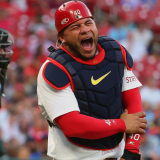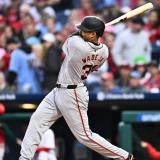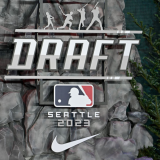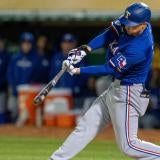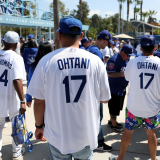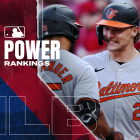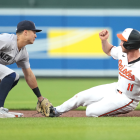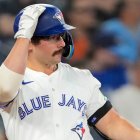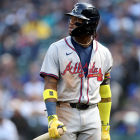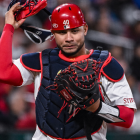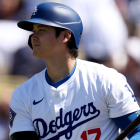Over the next seven weeks MLB teams will remake their rosters leading up to the July 31 trade deadline. Contenders will buy, rebuilders will sell, and teams in the middle may do a little of both. The trade deadline affects free agency because it can take the qualifying offer out of play, and because players can sign extensions with their new teams. None of that has happened yet, however.
As we've been doing all season, we're going to keep tabs on the 2019-20 free-agent class with weekly Stock Watch posts, and also rank the top impending free agents at the start of each month. Here are our MLB Free Agent Power Rankings for June. Even with all those early season extensions, there will be some truly elite talent on the market this winter. Unless those players sign extensions between now and then, that is. Here are two impending free agents on the rise and two trending down.
Stock Up
Quite simply, Didi Gregorius' free-agent stock is up because he is healthy. Gregorius had Tommy John surgery in October and missed the first few weeks of the season while rehabbing. He's completed his rehab, completed his minor-league tune-up stint, and is now back with the Yankees. Sir Didi has played four games and is 6 for 14 (.429) at the plate.
Over the weekend the 29-year-old Gregorius socked a home run and showed his swing and his sneaky power are still there post-elbow surgery:
With Xander Bogaerts signing a long-term extension a few weeks ago, Gregorius is the best shortstop scheduled to become a free agent after the season. It's Gregorius and, uh, Jose Iglesias? Iglesias is having a pretty good year! But Gregorius is essentially Iglesias with more offense. Iglesias and Freddy Galvis are the top non-Didi impending free-agent shortstops.
There is still a lot of season to be played and we'll see what Gregorius looks like as the at-bats and defensive innings pile up. For now, Gregorius has completed Step 1 in his free-agent stock rebuild, and that's getting back on the field. It's an important step. Maybe the most important step. Didi's rehab is complete and he is now back in the lineup and showing teams what he can do. The early returns are promising.
At 28-38, the Giants have one of the worst records in baseball this year, and it would be a heck of a lot worse without their lockdown bullpen. San Francisco's relief crew owns a 3.78 ERA and is ninth in baseball with 2.1 WAR. Nineteen of their 28 wins have been decided by no more than two runs. The Giants win close games and nothing else, basically.
Anchoring the Giants bullpen is closer Will Smith, who returned from Tommy John surgery last season to throw 53 innings with a 2.55 ERA and 71 strikeouts. Smith has been even better this year:
| IP | ERA | WHIP | Strikeout Rate | Walk Rate | Ground Ball Rate | |
|---|---|---|---|---|---|---|
2018 | 53 | 2.55 | 0.98 | 33.8% | 7.1% | 41.7% |
2019 | 26 2/3 | 2.05 | 0.75 | 38.8% | 6.1% | 44.4% |
The underlying contact quality numbers like exit velocity allowed are relatively unchanged from last year, which is a good thing, because Smith didn't allow much hard contact last year. A rental lefty reliever who suppresses hard contact, keeps the ball on the ground when he isn't striking everyone out, and has late-game experience will be in very high demand at the trade deadline.
With Dellin Betances dealing with an ongoing shoulder issue, Smith is now in line to be the best reliever in free agency after the season. He's excellent, he's doing it for the second year in a row, and he's shown he's over Tommy John surgery. This past offseason Adam Ottavino signed a three-year, $27 million contract and consider:
- Smith will be three years younger this winter than Ottavino was last winter.
- Ottavino was also two years removed from Tommy John surgery (well, two and a half).
- Smith will go into free agency with two dynamite seasons post-surgery. Ottavino had just one.
That all points to Smith receiving a larger contract than Ottavino's three-year pact. Will that actually happen? Who knows. Free agency is unpredictable these days. Relievers are still get paid well though, and Smith has pitched himself into position for a very nice free-agent payday. He's healthy and he's putting together back-to-back elite seasons.
Stock Down
There is pretty much nothing Jason Kipnis can do this season to convince the Indians to pick up his $16.5 million club option for 2020. Even with a sudden return to 2013-16 Kipnis levels, Cleveland would declined the option, pay him the $2.5 million buyout, and (maybe) negotiate a new contract with a lower salary. Kipnis was always destined for free agency.
Forty-seven games into his season, Kipnis has not given anyone any reason to think otherwise. He's hitting .218/.272/.307 on the year. That's after hitting .230/.315/.389 last year and .232/.291/.414 the year before. In nearly 1,200 plate appearances the last three years, Kipnis has been a .229/.300/.383 hitter. The underlying Statcast numbers are not good either:
- Exit velocity: 86.8 mph (20th percentile)
- Hard-hit rate: 35.8 percent (35th percentile)
- Expected batting average: .268 (67th percentile)
- Expected slugging percentage: .392 (31st percentile)
- Expected weighted on-base average: .314 (36th percentile)
The expected batting average isn't all that bad. Everything else though, including the actual batting average? Yikes. Factor in second base defense that has rated as below average the last few years and Kipnis is short on silver linings. Going forward, he might be a platoon corner infielder (and/or corner outfielder?) who can play second in a pinch, and how much value is there in that?
It could be decent amount, honestly. That is more or less what Derek Dietrich is doing for the Reds this year. Of course, Dietrich is whacking home runs at an incredible rate, and Kipnis' offense is in decline. Point is, I think there's enough name value and track record here, as well as possible versatility, to get Kipnis a contract after the season. It'll almost certainly be a low base salary one-year deal though. Hard to ignore how much he's declined the last three years.
Let me start by stating the obvious: J.D. Martinez is still really, really good. The man is hitting .300/.376/.529 with 12 home runs with the lowest strikeout rate (17.1) of his career by more than four full percentage points. Martinez is on the very short list of hitters I want at the plate in a big situation. Or any situation, really. The guy is a terror at the plate.
Now, that all said, Martinez is not particularly close to hitting as well as he did last year (.330/.402/.629). In fact, according to park-adjusted OPS+, Martinez is having his worst offensive season since reinventing himself with the Tigers back in 2014. The underlying contact quality numbers are both elite and down from Martinez's last few seasons:
- Hard-hit rate: 47.8 percent (down from 52.4 percent last year)
- Barrel rate: 14.1 percent (down from 16.0 percent last year)
(Barrels are essentially the ideal combination of exit velocity and launch angle, according to Statcast. Those are the batted balls that tend to result in maximum damage.)
We're nitpicking, I know. Pointing out Martinez's production and contact quality is down a tad is like hating on the Mona Lisa for her smile. He's so good. This is the thing though: Martinez's numbers are down, he's been dealing with nagging back spasms the last few weeks, and he is a soon-to-be 32-year-old most of the time DH. If you don't think that will all work against him in free agency, you haven't been paying attention to the market.
The good news? Martinez is in complete control of his situation. He becomes a free agent only if he wants to become a free agent. His five-year, $110 million contract includes an opt-out following 2019 (and 2020). If he exercises the opt-out, Martinez would walk away from three years and $60 million. Coming into the season, I considered opting out a distinct possibility because Martinez is so good. Now, with some red flags maybe starting to pop up, I'm not so sure.
The key number is $60 million. To come out ahead after using the opt out, Martinez has wind up with more than $60 million in free agency. That could be two years and $62 million, or three years and $63 million, or four years and $65 million. As long as is is more than $60 million, it was worth it. Can this version of Martinez land more than $60 million in free agency? Consider:
| Age at Free Agency | AVG/OBP/SLG | HR | WAR | Contract | |
|---|---|---|---|---|---|
2016 Edwin Encarnacion | 34 | .263/.357/.529 | 42 | 3.8 | 3 years, $60M |
2017 Carlos Santana | 32 | .259/.363/.455 | 23 | 3.4 | 3 years, $60M |
2019 J.D. Martinez | 32 | .300/.376/.529 | 28 (pace) | 3.5 (pace) | ??? |
Based on the contract year comparisons to Encarnacion and Santana, Martinez does deserve $60-ish million as a free agent after the season. Now if we could only transport Martinez back to the 2016-17 or 2017-18 offseasons. The market is much different now, and remember, Encarnacion had some trouble finding a contract as a free agent. He didn't sign until January.
Martinez himself had to wait until late February to sign last offseason, and that was after hitting 45 home runs in 119 games in 2017. Fair or not, teams are steering clear of players on the wrong side of 30. Martinez is great, but he has an injury history and isn't far away from being a full-time DH. I have a very hard time thinking a club will guarantee him $60 million this winter, and that's on the teams and the way they operate, not Martinez. He's not doing anything wrong.
I came into 2019 under the assumption Martinez would opt out after the season, or at least leverage the opt-out clause into an extension or more guaranteed money a la Clayton Kershaw last winter. Now I don't think it happens. Not unless Martinez goes on a huge tear to finish the season, which is entirely possible. For now, I think Martinez stays. With a big 2020, he could opt out next offseason and would only have to beat $38.75 million guaranteed.















